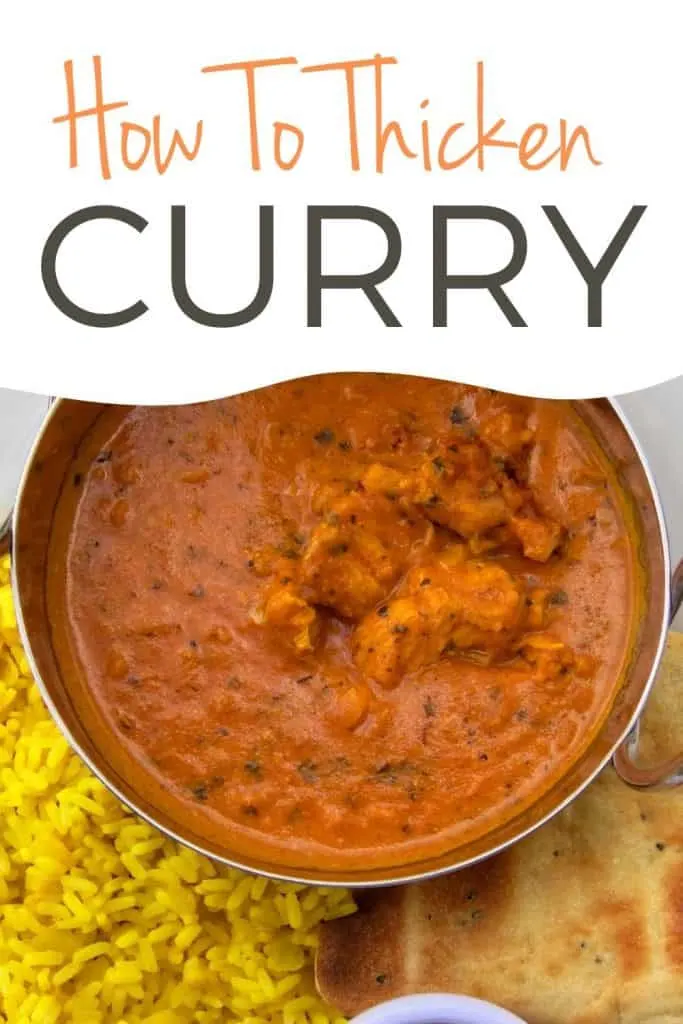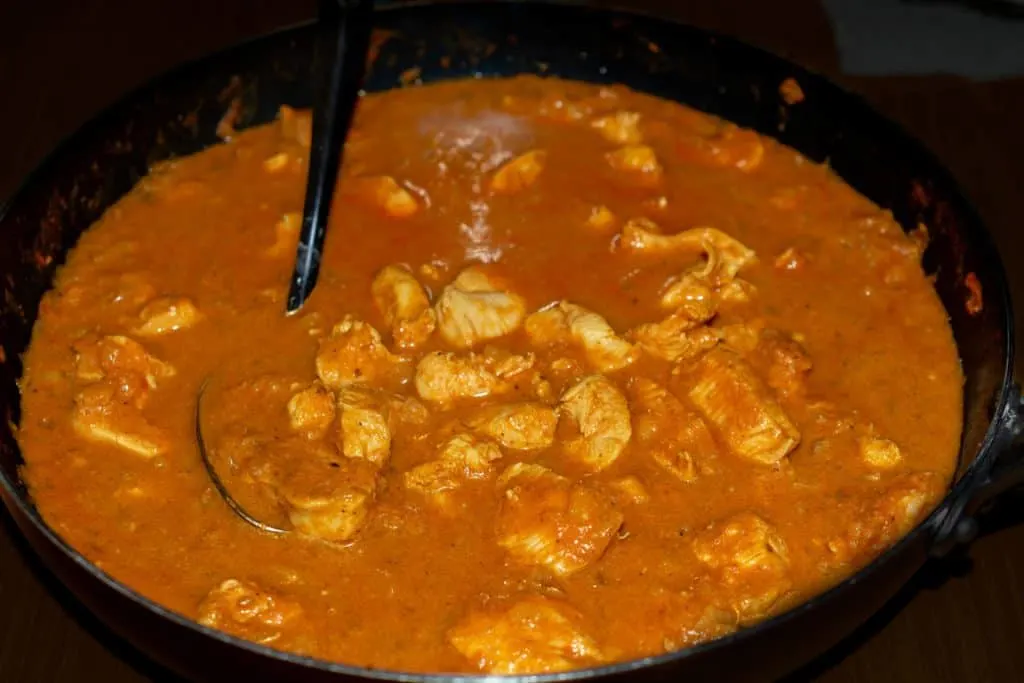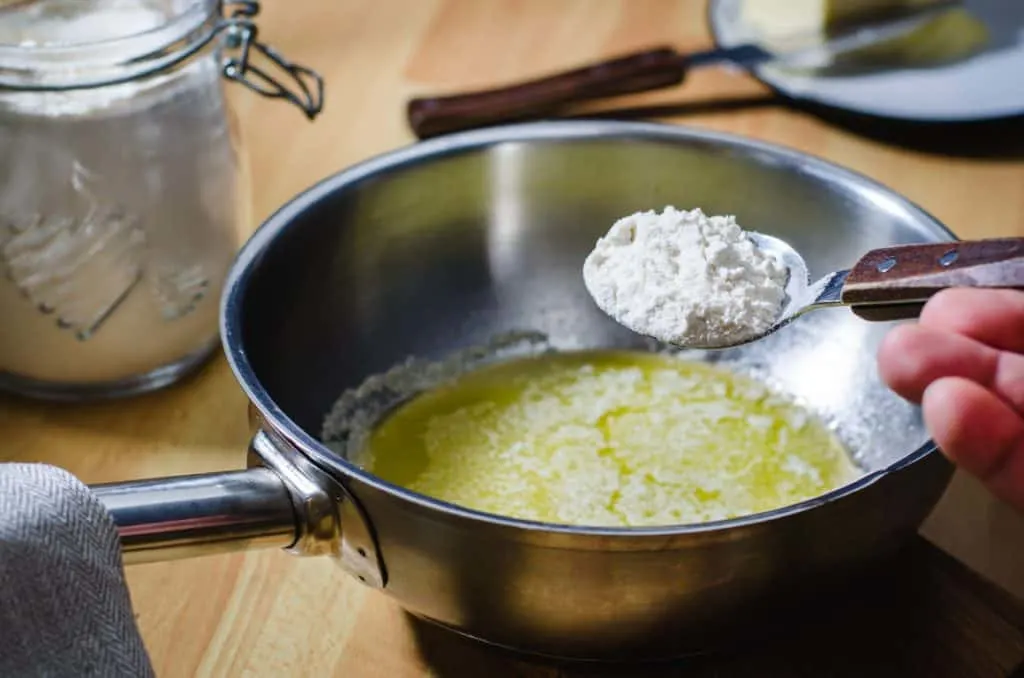Learn how to thicken curry the easy way! We’ve covered 9 different ways to make a curry thicker so that you never need to suffer a watery curry sauce again.
Have you ever wondered why the curry at your favourite curry house is always thick and creamy while the one you try to make at home often ends up thin and watery?
Curry sauce can of course be thick or thin, depending on your preference. But generally, the ideal consistency would be one that’s not too runny and not too thick, either.
How Thick Should Curry Sauce Be?
Curry sauce should be thick enough so it coats all the ingredients in the dish. But it should also be fluid enough to spill over the rice on your plate and dip your pita or flatbread into.
If you find it challenging to achieve that right kind of thickness, follow these tips using ingredients you likely have in the kitchen already.
With these tricks, you’ll finally be able to whip up a rich, full-flavoured chicken tikka masala that will have family and guests craving for more.
Related – How To Thicken Soup
1. Simmer
The simplest thing you can do is simmer the sauce for an extended period, about 15 to 30 minutes, to reduce the liquid.
Make sure the heat is on low so you won’t end up drying the sauce too much, overcooking some ingredients, or worse, burning the bottom of the curry.
To avoid overcooking vegetables in a curry, delay adding them in. Wait until the meat and sauce have rendered down and thickened slightly before adding potatoes, beans, and other vegetables you wish to include.
Also, when simmering for thickness, be sure to leave the pot uncovered so the steam can evaporate easily.
2. Thicken With Flour
Using corn starch or regular wheat flour is also an easy and popular way to thicken any sauce. For every cup of liquid in your curry, prepare 2 teaspoons of flour added with enough water to make a slurry.
Pour the mixture in, stirring constantly. Do this near the end of the cooking process since the sauce can thicken rather fast and may stick to the bottom of the pan if you overcook it.
An alternative you can use is arrowroot, rice, or coconut flour which are all gluten-free. Arrowroot, in particular, is more heat-stable than corn or wheat and is more neutral in taste.
Rice and coconut flour may be available only at vegan, Asian, or ethnic foods stores, or on Amazon.
3. Combine Coconut
If you want to achieve an authentically Asian – particularly Indian and Thai – flavour, use coconut.
Whether you use it in milk, cream, or grated form, it’ll lend a mild, sweet, and creamy taste to your curry. It will also make the sauce smoother in texture. Coconut works especially well with masala-style recipes.
If you’re using canned coconut milk, add half a cup (50g) to your curry sauce and stir gently while simmering over low heat. It’s important not to shake or stir the can before opening it, as the thick cream usually floats on top. Scoop out and use that cream first, then just add and thin as needed using the remaining liquid.
4. Make A Roux
A roux is an all-time favourite thickener used by French cooks to thicken soups, stews, gravies, and sauces. It’s a mixture of flour and fat in the form of butter, lard, or bacon drippings.
Vegetable oil may also be used, but it won’t lend as much flavour as butter, lard, or bacon. It also might separate upon cooking, the way olive oil does. Fats that solidify at room temperature work best.
Making Roux To Thicken A Curry
- Use 2 tablespoons of fat and 2 tablespoons of flour for every cup (240ml) of liquid in your curry.
- Cook to your desired smoothness and level of brownness. A browner roux will result in a fragrant, slightly nutty smell and taste. If you don’t prefer that kind of flavour blending into your curry, opt for a lighter or “white” roux.
- Turn the heat off as soon as the flour has blended smoothly with the fat and you can no longer detect a raw flour taste – around 5 minutes.
5. Use Yoghurt
Yoghurt brings a rich, creamy tang into sauces. Full-fat and Greek-style yoghurt work best, as they’re thick and creamy and won’t curdle when incorporated into sauces.
Just add a little at a time, stirring gently and constantly until well-blended. Lower the heat to a very slight simmer to minimise any chance of curdling.
6. Add tomato Paste/Puree
Tomato paste or puree is the best thickener for tomato-based sauces, so if the recipe you’re making has some tomatoes in it, you’d be safest using tomato puree. The best time to add it is at the beginning of the cooking process so it incorporates well with all the other ingredients.
7. Add Lentils Or Legume Puree
A lot of Indian curries use a small amount of lentils – around 1 or 2 tablespoons – as these serve to thicken and bulk up the dish.
As they cook, lentils swell, soften, and then breakdown, soaking up the excess liquid in sauces. Other alternatives are chickpeas, beans, and other legumes, pureed into a smooth paste.
8. Add Some Ground Nuts Or Peanut Butter
Consider also pureeing a handful of unsalted raw cashews, almonds, or peanuts. As a substitute, you can use 1 to 2 tablespoons of smooth peanut butter. That may alter the taste a bit, which may or may not suit your preference. But remember that peanuts are a common addition to many South and East Asian dishes, so adding them to your curry can only give it a more authentic Eastern flavour.
9. Puree Some Of The Ingredients
Depending on the type of curry you’re making, you can use some of the ingredients in the dish itself to produce a thick paste. Potatoes, squash, carrots, legumes, and even some of the meat can be removed and blended separately in a food processor, depending on the size of the curry, only about a quarter of it, and then added back into the sauce.
This will thicken your curry fast without you having to use fat, flour, creams, or nuts that could affect the final flavour of your curry.
What If The Curry Sauce Is Too Thick?
If for some reason you ended up with a sauce that’s thicker than you would’ve preferred, just thin it down again by adding some water. If on the other hand your sauce still ended up thin, just redo any of the above methods you employed. Or try the other ones. Feel free to test and tweak according to your preferences.
How To Thicken Up A Curry In A Slow Cooker
When you make a curry in a slow cooker, sometimes you can end up with more liquid at the end then you intended. This is because some ingredients release a lot of liquid during the slow cook time and it has nowhere to go, because of the lid.
You can follow the same tips as above, they should all work the same. My first option would be to remove the lid for the last 30 minutes of cooking time, assuming there is enough time.
Related – Slow Cooker Chicken Curry



